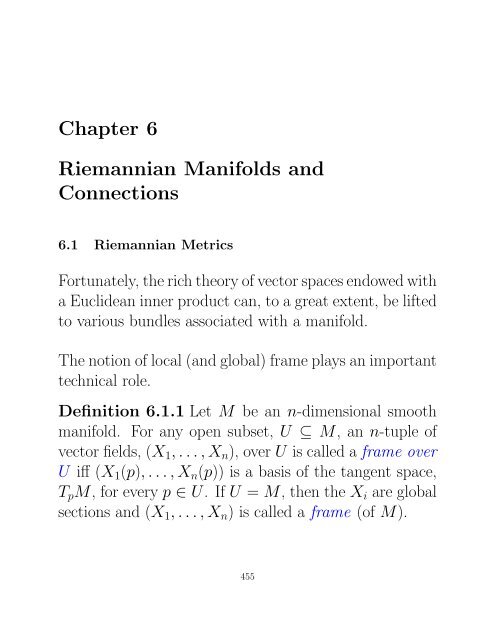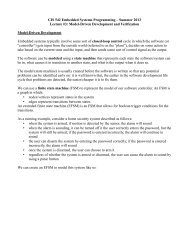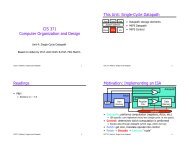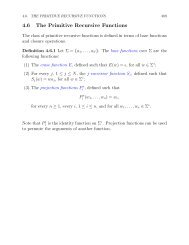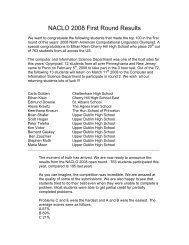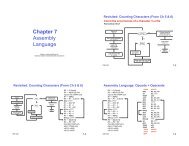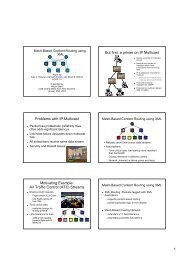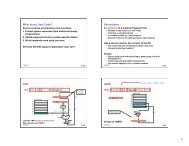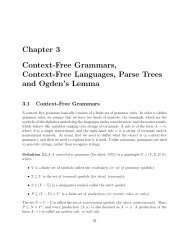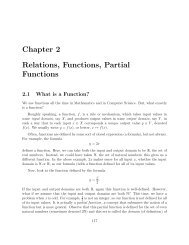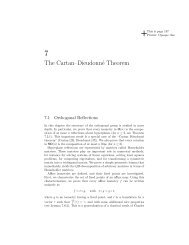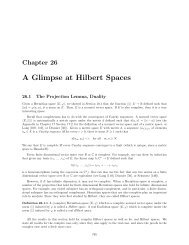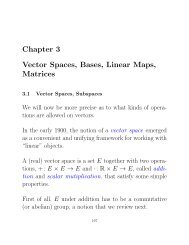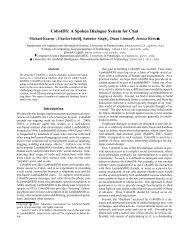Chapter 6 Riemannian Manifolds and Connections
Chapter 6 Riemannian Manifolds and Connections
Chapter 6 Riemannian Manifolds and Connections
Create successful ePaper yourself
Turn your PDF publications into a flip-book with our unique Google optimized e-Paper software.
<strong>Chapter</strong> 6<br />
<strong>Riemannian</strong> <strong>Manifolds</strong> <strong>and</strong><br />
<strong>Connections</strong><br />
6.1 <strong>Riemannian</strong> Metrics<br />
Fortunately, the rich theory of vector spaces endowed with<br />
aEuclideaninnerproductcan,toagreatextent,belifted<br />
to various bundles associated with a manifold.<br />
The notion of local (<strong>and</strong> global) frame plays an important<br />
technical role.<br />
Definition 6.1.1 Let M be an n-dimensional smooth<br />
manifold. For any open subset, U ⊆ M, ann-tuple of<br />
vector fields, (X1,...,Xn), over U is called a frame over<br />
U iff (X1(p),...,Xn(p)) is a basis of the tangent space,<br />
TpM, foreveryp ∈ U. IfU = M, thentheXi are global<br />
sections <strong>and</strong> (X1,...,Xn) iscalledaframe (of M).<br />
455
456 CHAPTER 6. RIEMANNIAN MANIFOLDS AND CONNECTIONS<br />
The notion of a frame is due to Élie Cartan who (after<br />
Darboux) made extensive use of them under the name of<br />
moving frame (<strong>and</strong> the moving frame method).<br />
Cartan’s terminology is intuitively clear: As a point, p,<br />
moves in U, theframe,(X1(p),...,Xn(p)), moves from<br />
fibre to fibre. Physicists refer to a frame as a choice of<br />
local gauge.<br />
If dim(M) =n, thenforeverychart,(U, ϕ), since<br />
dϕ −1<br />
ϕ(p) : Rn → TpM is a bijection for every p ∈ U, the<br />
n-tuple of vector fields, (X1,...,Xn), with<br />
Xi(p) = dϕ −1<br />
ϕ(p) (ei), is a frame of TM over U, where<br />
(e1,...,en) isthecanonicalbasisofRn .<br />
The following proposition tells us when the tangent bundle<br />
is trivial (that is, isomorphic to the product, M ×R n ):
6.1. RIEMANNIAN METRICS 457<br />
Proposition 6.1.2 The tangent bundle, TM, of a<br />
smooth n-dimensional manifold, M, is trivial iff it<br />
possesses a frame of global sections (vector fields defined<br />
on M).<br />
As an illustration of Proposition 6.1.2 we can prove that<br />
the tangent bundle, TS 1 ,ofthecircle,istrivial.<br />
Indeed, we can find a section that is everywhere nonzero,<br />
i.e. anon-vanishingvectorfield,namely<br />
X(cos θ, sin θ) =(− sin θ, cos θ).<br />
The reader should try proving that TS 3 is also trivial (use<br />
the quaternions).<br />
However, TS 2 is nontrivial, although this not so easy to<br />
prove.<br />
More generally, it can be shown that TS n is nontrivial<br />
for all even n ≥ 2. It can even be shown that S 1 , S 3 <strong>and</strong><br />
S 7 are the only spheres whose tangent bundle is trivial.<br />
This is a rather deep theorem <strong>and</strong> its proof is hard.
458 CHAPTER 6. RIEMANNIAN MANIFOLDS AND CONNECTIONS<br />
Remark: Amanifold,M, suchthatitstangentbundle,<br />
TM,istrivialiscalledparallelizable.<br />
We now define <strong>Riemannian</strong> metrics <strong>and</strong> <strong>Riemannian</strong> manifolds.<br />
Definition 6.1.3 Given a smooth n-dimensional manifold,<br />
M, a<strong>Riemannian</strong> metric on M (or TM) is a<br />
family, (〈−, −〉p)p∈M, ofinnerproductsoneachtangent<br />
space, TpM, suchthat〈−, −〉p depends smoothly on p,<br />
which means that for every chart, ϕα: Uα → R n ,forevery<br />
frame, (X1,...,Xn), on Uα, themaps<br />
p ↦→ 〈Xi(p),Xj(p)〉p, p ∈ Uα, 1 ≤ i, j ≤ n<br />
are smooth. A smooth manifold, M, witha<strong>Riemannian</strong><br />
metric is called a <strong>Riemannian</strong> manifold.
6.1. RIEMANNIAN METRICS 459<br />
If dim(M) =n, thenforeverychart,(U, ϕ), we have the<br />
frame, (X1,...,Xn), over U, withXi(p) =dϕ −1<br />
ϕ(p) (ei),<br />
where (e1,...,en) isthecanonicalbasisofR n .Sinceev-<br />
ery vector field over U is a linear combination, n<br />
i=1 fiXi,<br />
for some smooth functions, fi: U → R, theconditionof<br />
Definition 6.1.3 is equivalent to the fact that the maps,<br />
p ↦→ 〈dϕ −1 −1<br />
ϕ(p) (ei),dϕϕ(p) (ej)〉p, p ∈ U, 1 ≤ i, j ≤ n,<br />
are smooth. If we let x = ϕ(p), the above condition says<br />
that the maps,<br />
x ↦→ 〈dϕ −1<br />
x (ei),dϕ −1<br />
x (ej)〉 ϕ −1 (x), x ∈ ϕ(U), 1 ≤ i, j ≤ n,<br />
are smooth.<br />
If M is a <strong>Riemannian</strong> manifold, the metric on TM is often<br />
denoted g =(gp)p∈M. Inachart,usinglocalcoordinates,<br />
we often use the notation g = <br />
ij gijdxi ⊗ dxj or simply<br />
g = <br />
ij gijdxidxj, where<br />
<br />
∂ ∂<br />
gij(p) = ,<br />
.<br />
∂xi ∂xj<br />
p<br />
p<br />
p
460 CHAPTER 6. RIEMANNIAN MANIFOLDS AND CONNECTIONS<br />
For every p ∈ U, thematrix,(gij(p)), is symmetric, positive<br />
definite.<br />
The st<strong>and</strong>ard Euclidean metric on R n ,namely,<br />
g = dx 2 1 + ···+ dx 2 n,<br />
makes R n into a <strong>Riemannian</strong> manifold.<br />
Then, every submanifold, M, ofR n inherits a metric by<br />
restricting the Euclidean metric to M.<br />
For example, the sphere, S n−1 , inherits a metric that<br />
makes S n−1 into a <strong>Riemannian</strong> manifold. It is a good<br />
exercise to find the local expression of this metric for S 2<br />
in polar coordinates.<br />
Anontrivialexampleofa<strong>Riemannian</strong>manifoldisthe<br />
Poincaré upper half-space, namely,theset<br />
H = {(x, y) ∈ R 2 | y>0} equipped with the metric<br />
g = dx2 + dy2 y2 .
6.1. RIEMANNIAN METRICS 461<br />
Awaytoobtainametriconamanifold,N, istopullback<br />
the metric, g, onanothermanifold,M, alongalocal<br />
diffeomorphism, ϕ: N → M.<br />
Recall that ϕ is a local diffeomorphism iff<br />
dϕp: TpN → T ϕ(p)M<br />
is a bijective linear map for every p ∈ N.<br />
Given any metric g on M, ifϕ is a local diffeomorphism,<br />
we define the pull-back metric, ϕ ∗ g,onN induced by g<br />
as follows: For all p ∈ N, forallu, v ∈ TpN,<br />
(ϕ ∗ g)p(u, v) =g ϕ(p)(dϕp(u),dϕp(v)).<br />
We need to check that (ϕ ∗ g)p is an inner product, which<br />
is very easy since dϕp is a linear isomorphism.<br />
Our map, ϕ, between the two <strong>Riemannian</strong> manifolds<br />
(N,ϕ ∗ g)<strong>and</strong>(M,g) isalocalisometry,asdefinedbelow.
462 CHAPTER 6. RIEMANNIAN MANIFOLDS AND CONNECTIONS<br />
Definition 6.1.4 Given two <strong>Riemannian</strong> manifolds,<br />
(M1,g1)<strong>and</strong>(M2,g2), a local isometry is a smooth map,<br />
ϕ: M1 → M2, suchthatdϕp: TpM1 → T ϕ(p)M2 is an<br />
isometry between the Euclidean spaces (TpM1, (g1)p)<strong>and</strong><br />
(T ϕ(p)M2, (g2) ϕ(p)), for every p ∈ M1, thatis,<br />
(g1)p(u, v) =(g2) ϕ(p)(dϕp(u),dϕp(v)),<br />
for all u, v ∈ TpM1 or, equivalently, ϕ ∗ g2 = g1. Moreover,<br />
ϕ is an isometry iff it is a local isometry <strong>and</strong> a<br />
diffeomorphism.<br />
The isometries of a <strong>Riemannian</strong> manifold, (M,g), form a<br />
group, Isom(M,g), called the isometry group of (M,g).<br />
An important theorem of Myers <strong>and</strong> Steenrod asserts that<br />
the isometry group, Isom(M,g), is a Lie group.
6.1. RIEMANNIAN METRICS 463<br />
Given a map, ϕ: M1 → M2, <strong>and</strong>ametricg1 on M1, in<br />
general, ϕ does not induce any metric on M2.<br />
However, if ϕ has some extra properties, it does induce<br />
ametriconM2. This is the case when M2 arises from<br />
M1 as a quotient induced by some group of isometries of<br />
M1. For more on this, see Gallot, Hulin <strong>and</strong> Lafontaine<br />
[?], <strong>Chapter</strong> 2, Section 2.A.<br />
Now, because a manifold is paracompact (see Section<br />
4.6), a <strong>Riemannian</strong> metric always exists on M. This is<br />
aconsequenceoftheexistenceofpartitionsofunity(see<br />
Theorem 4.6.5).<br />
Theorem 6.1.5 Every smooth manifold admits a <strong>Riemannian</strong><br />
metric.
464 CHAPTER 6. RIEMANNIAN MANIFOLDS AND CONNECTIONS<br />
6.2 <strong>Connections</strong> on <strong>Manifolds</strong><br />
Given a manifold, M, in general, for any two points,<br />
p, q ∈ M, thereisno“natural”isomorphismbetween<br />
the tangent spaces TpM <strong>and</strong> TqM.<br />
Given a curve, c:[0, 1] → M, onM as c(t) moveson<br />
M, howdoesthetangentspace,T c(t)M change as c(t)<br />
moves?<br />
If M = R n ,thenthespaces,T c(t)R n ,arecanonically<br />
isomorphic to R n <strong>and</strong> any vector, v ∈ T c(0)R n ∼ = R n ,is<br />
simply moved along c by parallel transport,thatis,at<br />
c(t), the tangent vector, v, alsobelongstoT c(t)R n .<br />
However, if M is curved, for example, a sphere, then it is<br />
not obvious how to “parallel transport” a tangent vector<br />
at c(0) along a curve c.
6.2. CONNECTIONS ON MANIFOLDS 465<br />
Awaytoachievethisistodefinethenotionofparallel<br />
vector field along a curve <strong>and</strong> this, in turn, can be defined<br />
in terms of the notion of covariant derivative of a vector<br />
field.<br />
Assume for simplicity that M is a surface in R 3 . Given<br />
any two vector fields, X <strong>and</strong> Y defined on some open subset,<br />
U ⊆ R 3 ,foreveryp ∈ U, thedirectional derivative,<br />
DXY (p), ofY with respect to X is defined by<br />
DXY (p) =lim<br />
t→0<br />
Y (p + tX(p)) − Y (p)<br />
.<br />
t<br />
If f: U → R is a differentiable function on U, forevery<br />
p ∈ U,thedirectional derivative, X[f](p) (or X(f)(p)),<br />
of f with respect to X is defined by<br />
X[f](p) =lim<br />
t→0<br />
f(p + tX(p)) − f(p)<br />
.<br />
t<br />
We know that X[f](p) =dfp(X(p)).
466 CHAPTER 6. RIEMANNIAN MANIFOLDS AND CONNECTIONS<br />
It is easily shown that DXY (p)isR-bilinear in X <strong>and</strong> Y ,<br />
is C ∞ (U)-linear in X <strong>and</strong> satisfies the Leibnitz derivation<br />
rule with respect to Y ,thatis:<br />
Proposition 6.2.1 The directional derivative of vector<br />
fields satisfies the following properties:<br />
DX1+X2Y (p) =DX1Y (p)+DX2Y (p)<br />
DfXY (p) =fDXY (p)<br />
DX(Y1 + Y2)(p) =DXY1(p)+DXY2(p)<br />
DX(fY)(p) =X[f](p)Y (p)+f(p)DXY (p),<br />
for all X, X1,X2,Y,Y1,Y2 ∈ X(U) <strong>and</strong> all f ∈ C ∞ (U).<br />
Now, if p ∈ U where U ⊆ M is an open subset of M, for<br />
any vector field, Y ,definedonU (Y (p) ∈ TpM, forall<br />
p ∈ U), for every X ∈ TpM, thedirectionalderivative,<br />
DXY (p), makes sense <strong>and</strong> it has an orthogonal decomposition,<br />
DXY (p) =∇XY (p)+(Dn)XY (p),<br />
where its horizontal (or tangential) component is<br />
∇XY (p) ∈ TpM <strong>and</strong> its normal component is (Dn)XY (p).
6.2. CONNECTIONS ON MANIFOLDS 467<br />
The component, ∇XY (p), is the covariant derivative of<br />
Y with respect to X ∈ TpM <strong>and</strong> it allows us to define<br />
the covariant derivative of a vector field, Y ∈ X(U), with<br />
respect to a vector field, X ∈ X(M), on M.<br />
We easily check that ∇XY satisfies the four equations of<br />
Proposition 6.2.1.<br />
In particular, Y ,maybeavectorfieldassociatedwitha<br />
curve, c:[0, 1] → M.<br />
A vector field along a curve, c, is a vector field, Y ,such<br />
that Y (c(t)) ∈ T c(t)M, forallt ∈ [0, 1]. We also write<br />
Y (t) forY (c(t)).<br />
Then, we say that Y is parallel along c iff ∇ ∂/∂tY =0<br />
along c.
468 CHAPTER 6. RIEMANNIAN MANIFOLDS AND CONNECTIONS<br />
The notion of parallel transport on a surface can be defined<br />
using parallel vector fields along curves. Let p, q be<br />
any two points on the surface M <strong>and</strong> assume there is a<br />
curve, c:[0, 1] → M, joiningp = c(0) to q = c(1).<br />
Then, using the uniqueness <strong>and</strong> existence theorem for<br />
ordinary differential equations, it can be shown that for<br />
any initial tangent vector, Y0 ∈ TpM, thereisaunique<br />
parallel vector field, Y ,alongc, withY (0) = Y0.<br />
If we set Y1 = Y (1), we obtain a linear map, Y0 ↦→ Y1,<br />
from TpM to TqM which is also an isometry.<br />
As a summary, given a surface, M, ifwec<strong>and</strong>efineanotion<br />
of covariant derivative, ∇: X(M) × X(M) → X(M),<br />
satisfying the properties of Proposition 6.2.1, then we can<br />
define the notion of parallel vector field along a curve <strong>and</strong><br />
the notion of parallel transport, which yields a natural<br />
way of relating two tangent spaces, TpM <strong>and</strong> TqM, using<br />
curves joining p <strong>and</strong> q.
6.2. CONNECTIONS ON MANIFOLDS 469<br />
This can be generalized to manifolds using the notion of<br />
connection. We will see that the notion of connection<br />
induces the notion of curvature. Moreover, if M has a<br />
<strong>Riemannian</strong> metric, we will see that this metric induces<br />
auniqueconnectionwithtwoextraproperties(theLevi-<br />
Civita connection).<br />
Definition 6.2.2 Let M be a smooth manifold.<br />
A connection on M is a R-bilinear map,<br />
∇: X(M) × X(M) → X(M),<br />
where we write ∇XY for ∇(X, Y ), such that the following<br />
two conditions hold:<br />
∇fXY = f∇XY<br />
∇X(fY)=X[f]Y + f∇XY,<br />
for all X, Y ∈ X(M) <strong>and</strong>allf ∈ C ∞ (M). The vector<br />
field, ∇XY ,iscalledthecovariant derivative of Y with<br />
respect to X.<br />
AconnectiononM is also known as an affine connection<br />
on M.
470 CHAPTER 6. RIEMANNIAN MANIFOLDS AND CONNECTIONS<br />
Abasicpropertyof∇ is that it is a local operator.<br />
Proposition 6.2.3 Let M be a smooth manifold <strong>and</strong><br />
let ∇ be a connection on M. For every open subset,<br />
U ⊆ M, foreveryvectorfield,Y ∈ X(M), if<br />
Y ≡ 0 on U, then∇XY ≡ 0 on U for all X ∈ X(M),<br />
that is, ∇ is a local operator.<br />
Proposition 6.2.3 implies that a connection, ∇, onM,<br />
restricts to a connection, ∇ ↾ U, oneveryopensubset,<br />
U ⊆ M.<br />
It can also be shown that (∇XY )(p) onlydependson<br />
X(p), that is, for any two vector fields, X, Y ∈ X(M), if<br />
X(p) =Y (p) forsomep ∈ M, then<br />
(∇XZ)(p) =(∇Y Z)(p) for every Z ∈ X(M).<br />
Consequently, for any p ∈ M, thecovariantderivative,<br />
(∇uY )(p), is well defined for any tangent vector,<br />
u ∈ TpM, <strong>and</strong>anyvectorfield,Y ,definedonsomeopen<br />
subset, U ⊆ M, withp ∈ U.
6.2. CONNECTIONS ON MANIFOLDS 471<br />
Observe thaton U, then-tuple of vector fields,<br />
,isalocalframe.<br />
<br />
∂ ∂ ,..., ∂x1 ∂xn<br />
We can write<br />
∇ ∂<br />
∂xi<br />
∂<br />
∂xj<br />
<br />
=<br />
n<br />
k=1<br />
Γ k ij<br />
∂<br />
,<br />
∂xk<br />
for some unique smooth functions, Γ k ij, defined on U,<br />
called the Christoffel symbols.<br />
We say that a connection, ∇, isflat on U iff<br />
<br />
∂<br />
∇X =0, for all X ∈ X(U), 1 ≤ i ≤ n.<br />
∂xi
472 CHAPTER 6. RIEMANNIAN MANIFOLDS AND CONNECTIONS<br />
Proposition 6.2.4 Every smooth manifold, M, possesses<br />
a connection.<br />
Proof .Wecanfindafamilyofcharts,(Uα,ϕα), such<br />
that {Uα}α is a locally finite open cover of M. If(fα) is<br />
apartitionofunitysubordinatetothecover{Uα}α<strong>and</strong> if ∇α is the flat connection on Uα, thenitisimmediately<br />
verified that<br />
∇ = <br />
fα∇ α<br />
is a connection on M.<br />
α<br />
Remark: AconnectiononTM can be viewed as a linear<br />
map,<br />
∇: X(M) −→ Hom C ∞ (M)(X(M), (X(M)),<br />
such that, for any fixed Y ∈X(M), the map,<br />
∇Y : X ↦→ ∇XY ,isC ∞ (M)-linear, which implies that<br />
∇Y is a (1, 1) tensor.
6.3. PARALLEL TRANSPORT 473<br />
6.3 Parallel Transport<br />
The notion of connection yields the notion of parallel<br />
transport. First, we need to define the covariant derivative<br />
of a vector field along a curve.<br />
Definition 6.3.1 Let M be a smooth manifold <strong>and</strong> let<br />
γ:[a, b] → M be a smooth curve in M. Asmooth vector<br />
field along the curve γ is a smooth map,<br />
X:[a, b] → TM,suchthatπ(X(t)) = γ(t), for all<br />
t ∈ [a, b] (X(t) ∈ T γ(t)M).<br />
Recall that the curve, γ:[a, b] → M, issmoothiffγ is<br />
the restriction to [a, b] ofasmoothcurveonsomeopen<br />
interval containing [a, b].
474 CHAPTER 6. RIEMANNIAN MANIFOLDS AND CONNECTIONS<br />
Proposition 6.3.2 Let M be a smooth manifold, let<br />
∇ be a connection on M <strong>and</strong> γ:[a, b] → M be a smooth<br />
curve in M. There is a R-linear map, D/dt, defined<br />
on the vector space of smooth vector fields, X, along<br />
γ, whichsatisfiesthefollowingconditions:<br />
(1) For any smooth function, f:[a, b] → R,<br />
D(fX)<br />
dt<br />
= df<br />
dt<br />
X + f DX<br />
dt<br />
(2) If X is induced by a vector field, Z ∈ X(M),<br />
that is, X(t0) =Z(γ(t0)) for all t0 ∈ [a, b], then<br />
DX<br />
dt (t0) =(∇ γ ′ (t0) Z) γ(t0).
6.3. PARALLEL TRANSPORT 475<br />
Proof .Sinceγ([a, b]) is compact, it can be covered by a<br />
finite number of open subsets, Uα, suchthat(Uα,ϕα) isa<br />
chart. Thus, we may assume that γ:[a, b] → U for some<br />
chart, (U, ϕ). As ϕ ◦ γ:[a, b] → R n ,wecanwrite<br />
ϕ ◦ γ(t) =(u1(t),...,un(t)),<br />
where each ui = pri ◦ ϕ ◦ γ is smooth. Now, it is easy to<br />
see that<br />
γ ′ n<br />
<br />
dui ∂<br />
(t0) =<br />
dt ∂xi<br />
.<br />
i=1<br />
γ(t0)<br />
If (s1,...,sn) isaframeoverU, wecanwrite<br />
n<br />
X(t) = Xi(t)si(γ(t)),<br />
i=1<br />
for some smooth functions, Xi.
476 CHAPTER 6. RIEMANNIAN MANIFOLDS AND CONNECTIONS<br />
Then, conditions (1) <strong>and</strong> (2) imply that<br />
n<br />
DX<br />
dt =<br />
<strong>and</strong> since<br />
j=1<br />
<br />
dXj<br />
dt sj(γ(t))<br />
<br />
+ Xj(t)∇γ ′ (t)(sj(γ(t)))<br />
γ ′ (t) =<br />
n<br />
i=1<br />
dui<br />
dt<br />
∂<br />
∂xi<br />
<br />
γ(t)<br />
there exist some smooth functions, Γk ij, sothat<br />
n<br />
∇γ ′ (t)(sj(γ(t))) =<br />
It follows that<br />
DX<br />
dt =<br />
⎛<br />
n<br />
⎝ dXk<br />
dt<br />
k=1<br />
i=1<br />
= <br />
i,k<br />
+ <br />
ij<br />
dui<br />
dt ∇ ∂ (sj(γ(t)))<br />
∂xi<br />
dui<br />
dt Γk ijsk(γ(t)).<br />
Γ k ij<br />
dui<br />
dt Xj<br />
,<br />
⎞<br />
⎠ sk(γ(t)).<br />
Conversely, the above expression defines a linear operator,<br />
D/dt, <strong>and</strong>itiseasytocheckthatitsatisfies(1)<strong>and</strong>(2).
6.3. PARALLEL TRANSPORT 477<br />
The operator, D/dt is often called covariant derivative<br />
along γ <strong>and</strong> it is also denoted by ∇ γ ′ (t) or simply ∇ γ ′.<br />
Definition 6.3.3 Let M be a smooth manifold <strong>and</strong> let<br />
∇ be a connection on M. Foreverycurve,γ:[a, b] → M,<br />
in M, avectorfield,X, alongγ is parallel (along γ) iff<br />
DX<br />
dt =0.<br />
If M was embedded in R d ,forsomed, thentosaythat<br />
X is parallel along γ would mean that the directional<br />
derivative, (D γ ′X)(γ(t)), is normal to T γ(t)M.<br />
The following proposition can be shown using the existence<br />
<strong>and</strong> uniqueness of solutions of ODE’s (in our case,<br />
linear ODE’s) <strong>and</strong> its proof is omitted:
478 CHAPTER 6. RIEMANNIAN MANIFOLDS AND CONNECTIONS<br />
Proposition 6.3.4 Let M be a smooth manifold <strong>and</strong><br />
let ∇ be a connection on M. For every C 1 curve,<br />
γ:[a, b] → M, inM, foreveryt ∈ [a, b] <strong>and</strong> every<br />
v ∈ T γ(t)M, thereisauniqueparallelvectorfield,X,<br />
along γ such that X(t) =v.<br />
For the proof of Proposition 6.3.4 it is sufficient to consider<br />
the portions of the curve γ contained in some chart.<br />
In such a chart, (U, ϕ), as in the proof of Proposition<br />
6.3.2, using a local frame, (s1,...,sn), over U, wehave<br />
⎛<br />
⎞<br />
DX<br />
dt =<br />
n<br />
k=1<br />
⎝ dXk<br />
dt<br />
+ <br />
ij<br />
Γ k ij<br />
dui<br />
dt Xj<br />
⎠ sk(γ(t)),<br />
with ui = pri ◦ ϕ ◦ γ. Consequently,X is parallel along<br />
our portion of γ iff the system of linear ODE’s in the<br />
unknowns, Xk,<br />
dXk<br />
dt<br />
is satisfied.<br />
+ <br />
ij<br />
Γ k ij<br />
dui<br />
dt Xj =0, k =1,...,n,
6.3. PARALLEL TRANSPORT 479<br />
Remark: Proposition 6.3.4 can be extended to piecewise<br />
C 1 curves.<br />
Definition 6.3.5 Let M be a smooth manifold <strong>and</strong> let<br />
∇ be a connection on M. Foreverycurve,<br />
γ:[a, b] → M, inM, foreveryt ∈ [a, b], the parallel<br />
transport from γ(a) to γ(t) along γ is the linear<br />
map from T γ(a)M to T γ(t)M, which associates to any<br />
v ∈ T γ(a)M the vector, Xv(t) ∈ T γ(t)M, whereXv is<br />
the unique parallel vector field along γ with Xv(a) =v.<br />
The following proposition is an immediate consequence<br />
of properties of linear ODE’s:<br />
Proposition 6.3.6 Let M be a smooth manifold <strong>and</strong><br />
let ∇ be a connection on M. For every C 1 curve,<br />
γ:[a, b] → M, inM, theparalleltransportalongγ<br />
defines for every t ∈ [a, b] alinearisomorphism,<br />
Pγ: T γ(a)M → T γ(t)M, betweenthetangentspaces,<br />
T γ(a)M <strong>and</strong> T γ(t)M.
480 CHAPTER 6. RIEMANNIAN MANIFOLDS AND CONNECTIONS<br />
In particular, if γ is a closed curve, that is, if<br />
γ(a) =γ(b) =p, weobtainalinearisomorphism,Pγ, of<br />
the tangent space, TpM, calledtheholonomy of γ. The<br />
holonomy group of ∇ based at p, denotedHolp(∇), is<br />
the subgroup of GL(V,R) givenby<br />
Holp(∇) ={Pγ ∈ GL(V,R) |<br />
γ is a closed curve based at p}.<br />
If M is connected, then Holp(∇) dependsonthebasepoint<br />
p ∈ M up to conjugation <strong>and</strong> so Holp(∇) <strong>and</strong><br />
Holq(∇) areisomorphicforallp, q ∈ M. Inthiscase,it<br />
makes sense to talk about the holonomy group of ∇. By<br />
abuse of language, we call Holp(∇) theholonomy group<br />
of M.
6.4. CONNECTIONS COMPATIBLE WITH A METRIC 481<br />
6.4 <strong>Connections</strong> Compatible with a Metric;<br />
Levi-Civita <strong>Connections</strong><br />
If a <strong>Riemannian</strong> manifold, M,hasametric,thenitisnatural<br />
to define when a connection, ∇, onM is compatible<br />
with the metric.<br />
Given any two vector fields, Y,Z ∈ X(M), the smooth<br />
function, 〈Y,Z〉 ,is defined by<br />
for all p ∈ M.<br />
〈Y,Z〉(p) =〈Yp,Zp〉p,<br />
Definition 6.4.1 Given any metric, 〈−, −〉,onasmooth<br />
manifold, M, aconnection,∇, onM is compatible with<br />
the metric, forshort,ametric connection iff<br />
X(〈Y,Z〉) =〈∇XY,Z〉 + 〈Y,∇XZ〉,<br />
for all vector fields, X, Y, Z ∈ X(M).
482 CHAPTER 6. RIEMANNIAN MANIFOLDS AND CONNECTIONS<br />
Proposition 6.4.2 Let M be a <strong>Riemannian</strong> manifold<br />
with a metric, 〈−, −〉. Then, M, possesses metric<br />
connections.<br />
Proof .Foreverychart,(Uα,ϕα), we use the Gram-Schmidt<br />
procedure to obtain an orthonormal frame over Uα <strong>and</strong><br />
we let ∇ α be the trivial connection over Uα. By construction,<br />
∇ α is compatible with the metric. We finish<br />
the argumemt by using a partition of unity, leaving the<br />
details to the reader.<br />
We know from Proposition 6.4.2 that metric connections<br />
on TM exist. However, there are many metric connections<br />
on TM <strong>and</strong> none of them seems more relevant than<br />
the others.<br />
It is remarkable that if we require a certain kind of symmetry<br />
on a metric connection, then it is uniquely determined.
6.4. CONNECTIONS COMPATIBLE WITH A METRIC 483<br />
Such a connection is known as the Levi-Civita connection.<br />
The Levi-Civita connection can be characterized<br />
in several equivalent ways, a rather simple way involving<br />
the notion of torsion of a connection.<br />
There are two error terms associated with a connection.<br />
The first one is the curvature,<br />
R(X, Y )=∇ [X,Y ] + ∇Y ∇X −∇X∇Y .<br />
The second natural error term is the torsion, T (X, Y ),<br />
of the connection, ∇, givenby<br />
T (X, Y )=∇XY −∇Y X − [X, Y ],<br />
which measures the failure of the connection to behave<br />
like the Lie bracket.
484 CHAPTER 6. RIEMANNIAN MANIFOLDS AND CONNECTIONS<br />
Proposition 6.4.3 (Levi-Civita, Version 1) Let M<br />
be any <strong>Riemannian</strong> manifold. There is a unique, metric,<br />
torsion-free connection, ∇, onM, thatis,aconnection<br />
satisfying the conditions<br />
X(〈Y,Z〉) =〈∇XY,Z〉 + 〈Y,∇XZ〉<br />
∇XY −∇Y X =[X, Y ],<br />
for all vector fields, X, Y, Z ∈ X(M). This connection<br />
is called the Levi-Civita connection (or canonical<br />
connection) onM. Furthermore, this connection<br />
is determined by the Koszul formula<br />
2〈∇XY,Z〉 = X(〈Y,Z〉)+Y (〈X, Z〉) − Z(〈X, Y 〉)<br />
−〈Y,[X, Z]〉−〈X, [Y,Z]〉−〈Z, [Y,X]〉.
6.4. CONNECTIONS COMPATIBLE WITH A METRIC 485<br />
Proof .First,weproveuniqueness. Sinceourmetricis<br />
anon-degeneratebilinearform,itsufficestoprovethe<br />
Koszul formula. As our connection is compatible with<br />
the metric, we have<br />
X(〈Y,Z〉) =〈∇XY,Z〉 + 〈Y,∇XZ〉<br />
Y (〈X, Z〉) =〈∇Y X, Z〉 + 〈X, ∇Y Z〉<br />
−Z(〈X, Y 〉) =−〈∇ZX, Y 〉−〈X, ∇ZY 〉<br />
<strong>and</strong> by adding up the above equations, we get<br />
X(〈Y,Z〉)+Y (〈X, Z)〉 −Z(〈X, Y 〉) =<br />
〈Y,∇XZ −∇ZX〉<br />
+ 〈X, ∇Y Z −∇ZY 〉<br />
+ 〈Z, ∇XY + ∇Y X〉.<br />
Then, using the fact that the torsion is zero, we get<br />
X(〈Y,Z〉) +Y (〈X, Z〉) − Z(〈X, Y 〉) =<br />
〈Y,[X, Z]〉 + 〈X, [Y,Z]〉<br />
+ 〈Z, [Y,X]〉 +2〈Z, ∇XY 〉<br />
which yields the Koszul formula.<br />
We will not prove existence here. The reader should consult<br />
the st<strong>and</strong>ard texts for a proof.
486 CHAPTER 6. RIEMANNIAN MANIFOLDS AND CONNECTIONS<br />
Remark: In a chart, (U, ϕ), if we set<br />
∂kgij = ∂<br />
(gij)<br />
∂xk<br />
then it can be shown that the Christoffel symbols are<br />
given by<br />
Γ k ij = 1<br />
n<br />
g<br />
2<br />
kl (∂igjl + ∂jgil − ∂lgij),<br />
l=1<br />
where (g kl )istheinverseofthematrix(gkl).<br />
It can be shown that a connection is torsion-free iff<br />
Γ k ij =Γ k ji, for all i, j, k.<br />
We conclude this section with various useful facts about<br />
torsion-free or metric connections.<br />
First, there is a nice characterization for the Levi-Civita<br />
connection induced by a <strong>Riemannian</strong> manifold over a submanifold.
6.4. CONNECTIONS COMPATIBLE WITH A METRIC 487<br />
Proposition 6.4.4 Let M be any <strong>Riemannian</strong> manifold<br />
<strong>and</strong> let N be any submanifold of M equipped with<br />
the induced metric. If ∇ M <strong>and</strong> ∇ N are the Levi-Civita<br />
connections on M <strong>and</strong> N, respectively,inducedbythe<br />
metric on M, thenforanytwovectorfields,X <strong>and</strong><br />
Y in X(M) with X(p),Y(p) ∈ TpN, forallp ∈ N, we<br />
have<br />
∇ N XY =(∇ M X Y ) ,<br />
where (∇ M X Y ) (p) is the orthogonal projection of<br />
∇ M X Y (p) onto TpN, foreveryp ∈ N.<br />
In particular, if γ is a curve on a surface, M ⊆ R 3 ,then<br />
avectorfield,X(t), along γ is parallel iff X ′ (t) isnormal<br />
to the tangent plane, T γ(t)M.<br />
If ∇ is a metric connection, then we can say more about<br />
the parallel transport along a curve. Recall from Section<br />
6.3, Definition 6.3.3, that a vector field, X, alongacurve,<br />
γ, isparalleliff<br />
DX<br />
dt =0.
488 CHAPTER 6. RIEMANNIAN MANIFOLDS AND CONNECTIONS<br />
Proposition 6.4.5 Given any <strong>Riemannian</strong> manifold,<br />
M, <strong>and</strong>anymetricconnection,∇, onM, forevery<br />
curve, γ:[a, b] → M, onM, ifX <strong>and</strong> Y are two vector<br />
fields along γ, then<br />
d<br />
dt<br />
〈X(t),Y(t)〉 =<br />
<br />
DX<br />
dt ,Y<br />
<br />
Using Proposition 6.4.5 we get<br />
+<br />
<br />
X, DY<br />
dt<br />
<br />
.<br />
Proposition 6.4.6 Given any <strong>Riemannian</strong> manifold,<br />
M, <strong>and</strong>anymetricconnection,∇, onM, forevery<br />
curve, γ:[a, b] → M, onM, ifX <strong>and</strong> Y are two vector<br />
fields along γ that are parallel, then<br />
〈X, Y 〉 = C,<br />
for some constant, C. In particular, X(t) is constant.<br />
Furthermore, the linear isomorphism,<br />
Pγ: T γ(a) → T γ(b), isanisometry.<br />
In particular, Proposition 6.4.6 shows that the holonomy<br />
group, Holp(∇), based at p, isasubgroupofO(n).


